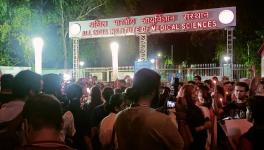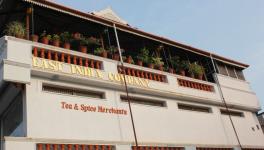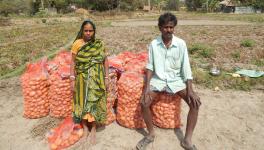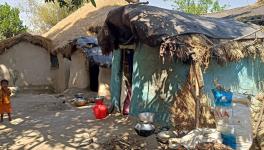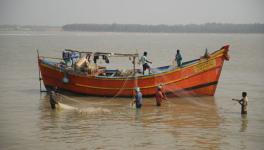Bengal: People Fear Losing Homes, Farmland as Sand Mining Further Erodes Damodar River Banks
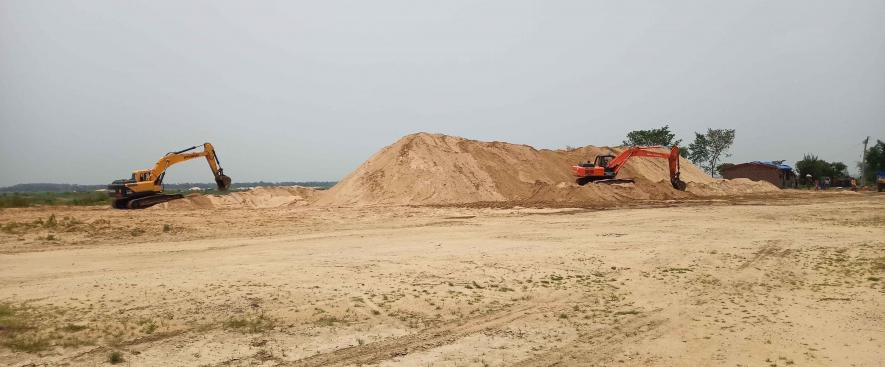
Illegal sand mining at Kuldanga village in Sonamukhi.
The banks of river Damodar flowing in Bankura district of West Bengal are eroding due to indiscriminate sand mining, affecting the lives of people living in adjoining areas.
Over the past 10 years, the river banks have seen JCB machines whizzing back and forth, carrying sand extracted from the river beds.
As a result, acre after acre of farmland and many homesteads are sinking with some even disappearing into the river.
Not only that, the river Damodar has now become a death trap due to unplanned sand mining, local residents told this writer. They claimed that 12 people had died in five years near the Durgapur Damodar Valley Corporation (DVC) barrage and adjoining areas of Barjora and Sonamukhi.
People alleged that the Trinamool Congress (TMC)-led state government was not taking necessary measures to change the situation despite appeals by the people, who have to battle against nature from the beginning of the monsoon to end of autumn.
Thousands of families from Barjora, Sonamukhi, Patrasayer blocks under Bankura District live on two banks of the river. Most of these families came here from East Pakistan (now Bangladesh) as refugees during the Partition. They faced all odds and started living on the banks of Damodar and cleared up the land for cultivation which was full of hazardous garbage. During this challenging time, the undivided communist party stood by them, the people said. After the formation of the Left Front government in 1977, these refugee families were handed over government land as patta (permanent settlement of land). This accorded them some social status and dignity.
But, after the TMC came to power in 2011, they witnessed a completely “different face” of the government. Several locals alleged that disregarding rules, rampant sand extraction from Damodar started in Barjora and Sonamukhi. They claimed that every year, erosion consumes the area’s land. But, the administration has been silent. No permanent solution has been implemented. The affected farmers have not got any compensation. Even the families of those who died in the sand trap did not receive any compensation, some villagers told this writer.
At present, the banks of the Damodar river in Barjora, Sonamukhi, Patrasayer are in a dangerous condition. If the river overflows this year from excess water released by DVC, both the banks may be washed away, they fear. Numerous acres of cultivable land and many houses may be swallowed by the river.
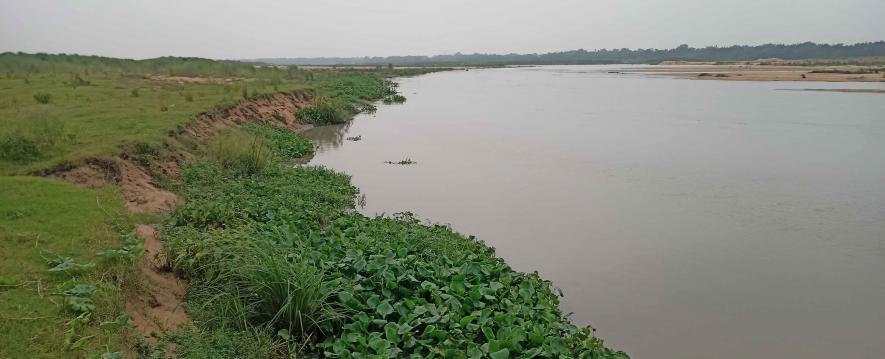
Damodar River bank erosion at Barishal Para, Barjora
As a result, thousands of families living on the banks of Damodar are in panic. They fear becoming refugees once again. Harekanta Kritoniya, 85, a resident of Manachor (river bank) Barishal para near Durgapur barrage in Barjora said he lives in fear. He came here along with hundreds of people as a refugee during Partition. Today, the same shadow of fear was visible in his eyes.
7 Decades Ago, Struggle for Survival was Intense
“I came to West Bengal from Barishal in East Pakistan (Now Bangladesh) with my father, mother, grandfather along with seven other family members during the Partition. We endured hardship and tremendous pain on the way to Bengal in search of shelter. We found shelter in the refugee camps of West Bengal that were mostly in and around Calcutta. I witnessed numerous deaths from starvation and lack of medical treatment in those refugee camps. We saw inhuman torture inflicted on women. We spend our days like nomads facing neglect and humiliation” recounted Kalipada Debnath, 94, a resident of Barishal para on the bank of Damodar in Barjora, who was a victim of Partition and landed on the bank of this river while searching for shelter.
Ganesh Chandra Ray, 90, of Ramkrishnapalli, Harekanto Kritoniya of Barishal para in Barjora, Jibon Biswas, Harogibinda Mandal of Koshba of Sonamukhi block told this writer that at that time, the banks of the Damodar river were full of poisonous weeds, snakes and various kinds of animals. The area was deserted; even cattle did not come anywhere near,
“We refugees risked our lives to clean this place and build huts of twigs to live here. No officers, employees from the administration at that time, or anyone from the then ruling Congress party ever came here. It was only the undivided communist party that stood by us, giving us courage. We formed a united central refugee council (UCRC). Our struggle began with a red flag demanding to live with dignity,” said Rabindranath Mandal, secretary of UCRC, Bankura district committee.
Mandal said, “This movement has not stopped. Even today, our movement continues raising various demands for the development of refugee areas and also to protect the Damodar River from further erosion.”
After 7 Decades, of Destruction
The persistent efforts of the people in the area, who arrived as refugees from Bangladesh, yielded crops from the rugged land. Ganash Ray of Ramkrishnapalli, Barjora, said they continue to make a living through farming. He noted that even though the Land Reform Act was introduced in the mid-50s, it was not implemented in Bengal.
“At that time, we fought to obtain government land as a “patta” because the land on which we began farming and living belonged to the government. However, the then government did not provide us any land ownership deeds (patta) for homesteads or agricultural land. Furthermore, the government paid no attention to the development work required for people to live in these areas. Many families were displaced annually due to river bank erosion, but the administration did not take any responsibility”, Ray told this writer.
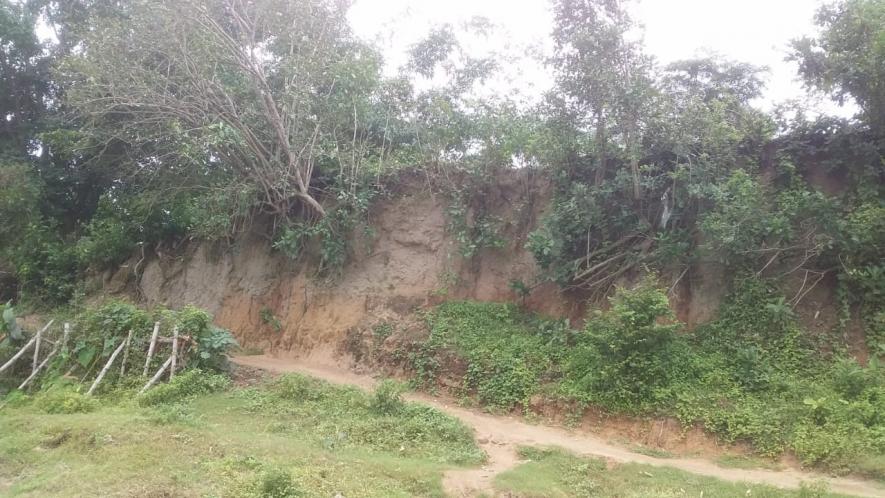
Erosion at Pakhonna, Barjora
He added that after the Left Front government came to power, they were granted ownership deeds for their homesteads and farmland.
“In Borishal Para, each family received a land patta of nine and a half bighas,” said Monmotho Kritoniya. He added that similar land pattas were given at Baromana, Pollishree, Ramkrishnapalli, Sitarampur, Pakhonna, Barjora block, Kosba under sonamukhi, Panchpara of Patrasayer block and several areas of Mejia, where refugees lived. During the Left Front’s rule, infrastructure, including schools, health centres, new roads, and drinking water facilities were established in these refugee colonies.
“The government provided them with dignity.” Jibon Bhattacharya, a professor and president of UCRC West Bengal, told this writer.
“In addition to receiving land ownership deeds, irrigation was provided on land, submersibles were installed in the areas along with water from Durgapur reservoir. The entire area along the Damodar bank turned green’’, Porimal Mondal and Sujon Mistri of Borishal Paratold this writer. They started cultivating various crops, including paddy, jute, and seasonal vegetables.
The people of these areas used to bring many vegetables to the market ahead of the season, earning better prices. These vegetables are sold in industrial towns like Durgapur, Aasalsol, Dhanbad, and Jamshedpur. Additionally, marigold, tuberose, roses, nuts and strawberries are also cultivated in this land.
According to people living on both sides of the Damodar, even 15-20 years ago, breaches occurred on both sides due to heavy rain and release of excess water from the Durgapur barrage into the river, however, a disaster was prevented by measures taken by the irrigation department of the Left Front government. People claimed that erosion was largely prevented by constructing guard walls and pocket dams near the Damodar’s banks resulting in minimal damage.
“After the TMC came to power in 2011, we witnessed a change in the government’s attitude toward refugee colonies,” Dilip Haldar, a resident of Pallishree, told this writer, adding that these colonies started getting ignored.
He said, “we have been pushed into a state of destruction due to unplanned sand mining.”
People living in these areas alleged that for about seven years, JCB machines were brought down to the riverbed to mine sand indiscriminately. People said they do not know whether sand mining is being done legally or illegally. They alleged that TMC activists were directly involved with the sand business. Until a few days ago, sand was being mined in the Brahmandiha area of Barjora, and it was entirely illegal. People alleged a relative of an elected TMC member was running the sand business.
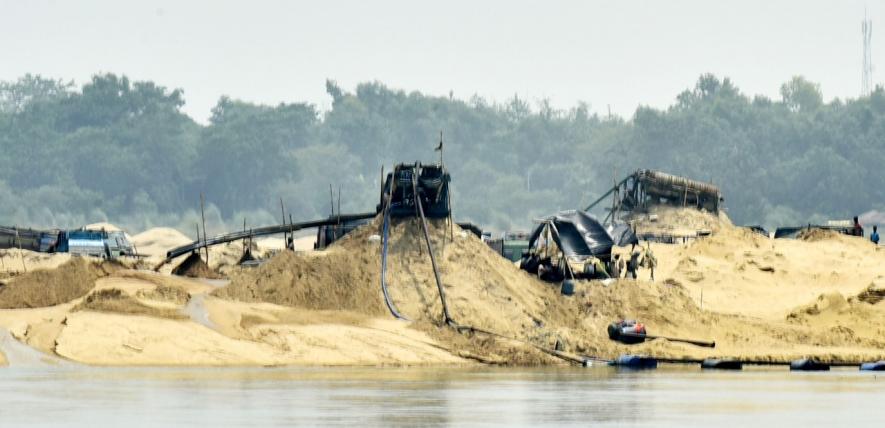
In Sonamukhi Munui village, sand being extracted illegally by inserting a 100 feet pipe inside the Damodar.
The Communist Party of India (Marxist) informed the Block Development Officer or BDO in writing about this. Sujoy Choudhury, a CPI(M) leader in Bankura, told this writer that strict action was not taken by the administration.
When asked, Surojit Mondal, the outgoing BDO of Barjora, told this writer, “I know this, there was an administrative drive to stop illegal sand mining once, but none was found,”
Meanwhile, people in the area claim that due to sand mining, the course of the river had shifted and it was moving toward their locality. In these 10 years, over 1,000 bighas of farmland had been destroyed in the Barjora area, said local residents.
Several houses were also been swallowed by the river. Landowners Monmotho Kritonia, Suren Sarkar, Romoni Ray said all these properties had ownership patta deeds. After losing their homes, several people had to buy land in other places.
A significant portion of those who lost their agricultural land now make quilts for a living.
An employee of Durgapur barrage, who wished to remain anonymous, said the sand accumulated in various places under the reservoir has not been cleaned for many years. Because of this, the water keeping capacity decreases. There is water only at a level 12 feet. After heavy rains and release of water from DVC’s Mithon Dam, the Durgapur barrage overflowed and all its 34 gates had to be opened for excess water release into the river. The whole area was flooded, which has led to further erosion of the banks of the river.
Rabindranath Mondal said no one knows where a death trap is hidden due to sand mining. A few days ago, a young teacher Manojit Mistri, of this village lost his life in this trap. Three people died in Sonamukhi’s Dihipara, and 10 boys have lost their lives in front of the barrage over these five years, he said.
He alleged that no compensation and proper action had been taken by the administration.
The fact is that the Durgapur barrage was brought under the control of the state government in 1965. It is now managed by the irrigation and waterway department of the state government. When asked, Arnab Ray, the SDO of this barrage, said “we have identified the erosion-prone areas through surveys and will take preventive measures when funds become available.” He did not specify the nature of these measures. Regarding the sand traps, he said they had alerted the people by using the microphone campaign and pasting awareness posters and leaflet distribution at various locations.
The writer covers the Jungle Mahal region for Ganashakti newspaper in West Bengal.
Get the latest reports & analysis with people's perspective on Protests, movements & deep analytical videos, discussions of the current affairs in your Telegram app. Subscribe to NewsClick's Telegram channel & get Real-Time updates on stories, as they get published on our website.









